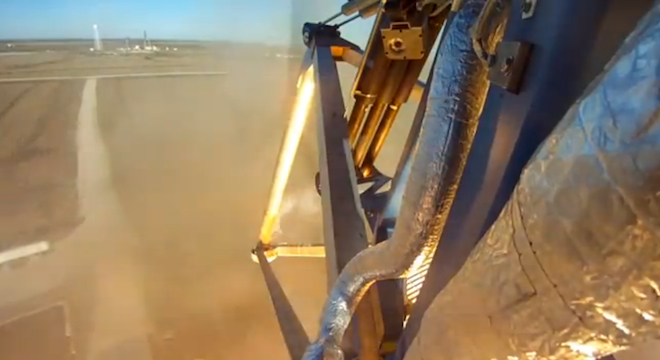Updated 5:22 p.m. EST, Friday, January 11
Flying aboard a reusable spacecraft still remains a futuristic fantasy for the time being. But SpaceX is bringing anyone with an Internet connection closer. Twelve stories closer, to be exact.
On Friday, the private spacefaring company founded by multi-industry entrepreneur Elon Musk published a previously unseen video of a test flight of its prototype reusable rocket design “Grasshopper,” captured from a camera aboard one of the rocket’s metal landing legs.
The video clearly shows the SpaceX Grasshopper, 106 ft. tall, lofting 12 stories (130 feet) straight up into the air and landing precisely back on the ground under its own power, a significant accomplishment in SpaceX’s quest to develop fully and rapidly reusable rockets, which Musk is adamant is the single major obstacle to affordable space travel.
Check out the video published Friday by SpaceX below:
The test flight was one of three such vertical takeoff, vertical landing (VTVL) runs conducted late last year by the company at its facility in McGregor, Texas. SpaceX filed permits with the government for plans to conduct an increasingly higher series of “test hops” using Grasshopper, up to 11,500 feet, through to 2015. In its documents with the Federal Aviation Administration, the company specified the rocket’s height.
The Grasshopper prototype is made up of some of SpaceX’s space-tested technology, reconfigured, including its Falcon 9 first stage booster rocket and Merlin engines, both of which were used to fly SpaceX’s unmanned Dragon cargo capsule to the Space Station twice in 2012, the first company in history to do so.
Separately from the Grasshopper, SpaceX is continuing development on Dragon and plans to conduct its first human-crewed test flights to the International Space Station by 2015, as Garrett Reisman, SpaceX’s Commercial Crew project manager revealed during a presentation Wednedsay alongside other private spacefaring companies and NASA, at the Kennedy Space Center.
“We plan to get to the point that we can fly to the International Space Station with non-NASA crew by 2015,” Reisman said. “So far, we’re on schedule.”
However, Resiman explained that SpaceX would have to use “a test pilot crew” assembled by SpaceX, not NASA astronauts, for these flights, as “we’re not allowed to legally use NASA astronauts as part of that test crew.”
SpaceX is one of four companies to win funding from NASA to pursue new commercial human spaceflight capabilities from U.S. soil, under NASA’s Commercial Crew Program (CCP). The other three are: Boeing, Sierra Nevada Corp. and Blue Origin, the latter of which was, like SpaceX, founded by an Internet entrepreneur — Amazon’s Jeff Bezos. See their plans going forward in a presentation document released by NASA on Friday (PDF).
SpaceX won $440 million as part of the competitive funding process, as well as a separate $1.6 billion contract for 12 cargo flights to the International Space Station.
Late update: Updated to add the Grasshopper’s height and documents from the Federal Aviation Administration and NASA.






